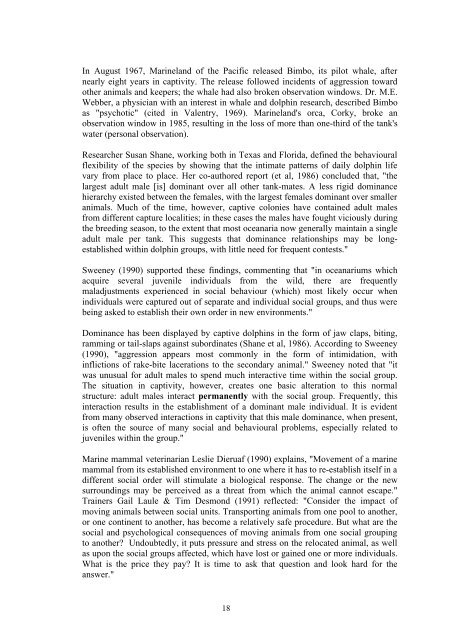Captive Cetaceans: A Handbook for Campaigners - Whale and ...
Captive Cetaceans: A Handbook for Campaigners - Whale and ...
Captive Cetaceans: A Handbook for Campaigners - Whale and ...
Create successful ePaper yourself
Turn your PDF publications into a flip-book with our unique Google optimized e-Paper software.
In August 1967, Marinel<strong>and</strong> of the Pacific released Bimbo, its pilot whale, after<br />
nearly eight years in captivity. The release followed incidents of aggression toward<br />
other animals <strong>and</strong> keepers; the whale had also broken observation windows. Dr. M.E.<br />
Webber, a physician with an interest in whale <strong>and</strong> dolphin research, described Bimbo<br />
as "psychotic" (cited in Valentry, 1969). Marinel<strong>and</strong>'s orca, Corky, broke an<br />
observation window in 1985, resulting in the loss of more than one-third of the tank's<br />
water (personal observation).<br />
Researcher Susan Shane, working both in Texas <strong>and</strong> Florida, defined the behavioural<br />
flexibility of the species by showing that the intimate patterns of daily dolphin life<br />
vary from place to place. Her co-authored report (et al, 1986) concluded that, "the<br />
largest adult male [is] dominant over all other tank-mates. A less rigid dominance<br />
hierarchy existed between the females, with the largest females dominant over smaller<br />
animals. Much of the time, however, captive colonies have contained adult males<br />
from different capture localities; in these cases the males have fought viciously during<br />
the breeding season, to the extent that most oceanaria now generally maintain a single<br />
adult male per tank. This suggests that dominance relationships may be longestablished<br />
within dolphin groups, with little need <strong>for</strong> frequent contests."<br />
Sweeney (1990) supported these findings, commenting that "in oceanariums which<br />
acquire several juvenile individuals from the wild, there are frequently<br />
maladjustments experienced in social behaviour (which) most likely occur when<br />
individuals were captured out of separate <strong>and</strong> individual social groups, <strong>and</strong> thus were<br />
being asked to establish their own order in new environments."<br />
Dominance has been displayed by captive dolphins in the <strong>for</strong>m of jaw claps, biting,<br />
ramming or tail-slaps against subordinates (Shane et al, 1986). According to Sweeney<br />
(1990), "aggression appears most commonly in the <strong>for</strong>m of intimidation, with<br />
inflictions of rake-bite lacerations to the secondary animal." Sweeney noted that "it<br />
was unusual <strong>for</strong> adult males to spend much interactive time within the social group.<br />
The situation in captivity, however, creates one basic alteration to this normal<br />
structure: adult males interact permanently with the social group. Frequently, this<br />
interaction results in the establishment of a dominant male individual. It is evident<br />
from many observed interactions in captivity that this male dominance, when present,<br />
is often the source of many social <strong>and</strong> behavioural problems, especially related to<br />
juveniles within the group."<br />
Marine mammal veterinarian Leslie Dieruaf (1990) explains, "Movement of a marine<br />
mammal from its established environment to one where it has to re-establish itself in a<br />
different social order will stimulate a biological response. The change or the new<br />
surroundings may be perceived as a threat from which the animal cannot escape."<br />
Trainers Gail Laule & Tim Desmond (1991) reflected: "Consider the impact of<br />
moving animals between social units. Transporting animals from one pool to another,<br />
or one continent to another, has become a relatively safe procedure. But what are the<br />
social <strong>and</strong> psychological consequences of moving animals from one social grouping<br />
to another? Undoubtedly, it puts pressure <strong>and</strong> stress on the relocated animal, as well<br />
as upon the social groups affected, which have lost or gained one or more individuals.<br />
What is the price they pay? It is time to ask that question <strong>and</strong> look hard <strong>for</strong> the<br />
answer."<br />
18

















